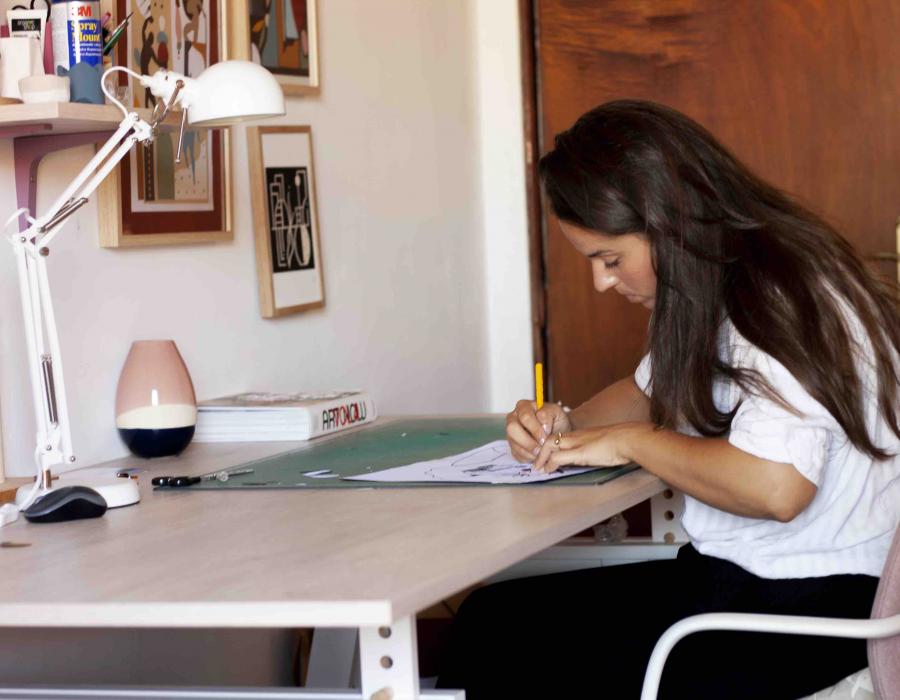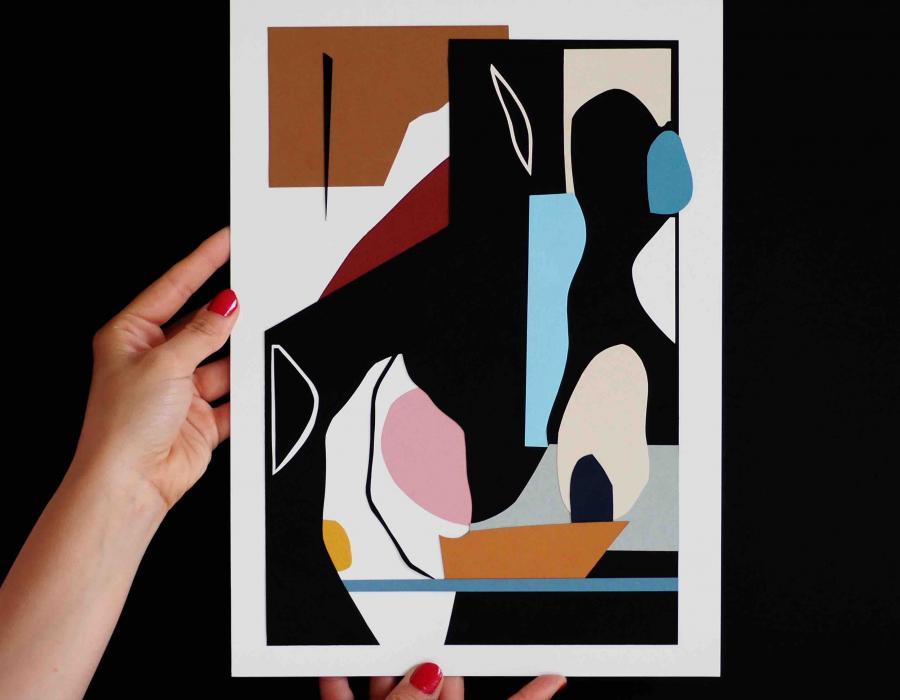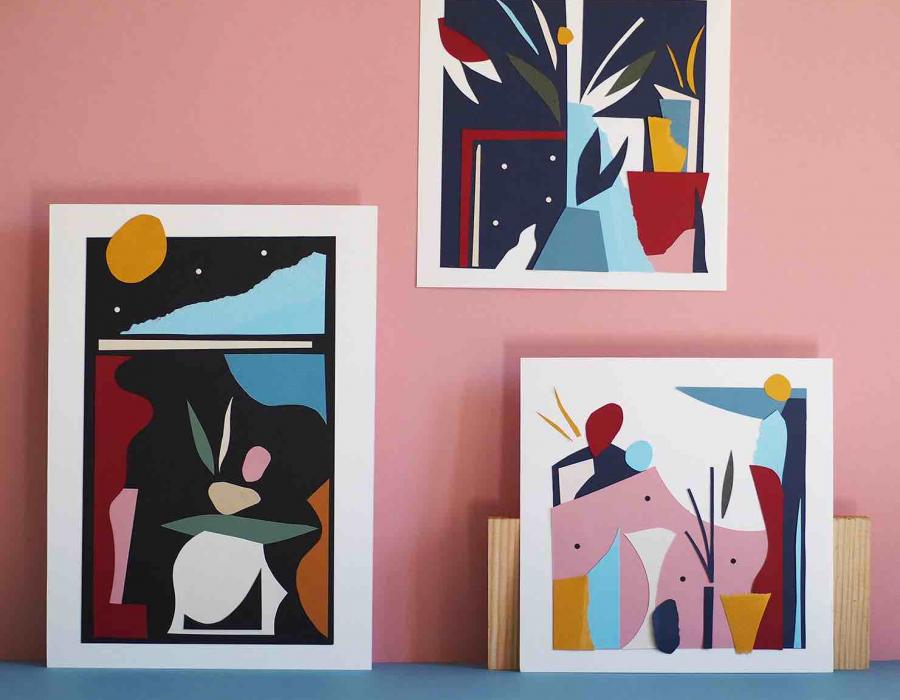We can use paper to tell stories and create emotion, not only through its aesthetic characteristics, but also through the way that we process it and compose with it. Nekane Jiménez, through her company Nekane, is well aware of this: she is an artist and a lecturer in art, and the best part of her work involves a very particular style which she calls ‘drawing and painting with paper’. We conversed at length about what working with this substrate means to her, the aspects she values most highly and how her work reaches her target’s senses.

What kind of projects do you do? For which target or which sectors?
I do mainly my own work. What I mean is that I create items to update my portfolio, to learn and grow. Moreover, I have an online store where I sell my paper drawings, and I also work with different spaces or galleries at home and abroad to sell and showcase items. Exhibitions and collaborations are part of my creative work.
The audience for whom my work is intended is quite varied, although they tend to be people who like this type of finished product, original items created manually in which you can see the material and the work process.
How did the idea of “drawing and painting with paper” arise? How has it evolved?
It was partly a survival thing. I did a postgraduate in illustration, and since I was and am still not exactly enamoured with digital tools, I had to find new resources and substrates for my projects and I started to do everything I could with paper up until today.
For this reason, I always say that I draw and paint with paper, it is a form of self-expression and it has evolved a lot more than I could have expected: with much more complex and larger images, with new research into forms and shapes, colours and materials.
The influences and the fondness that I acquired working with this material during my Fine Arts degree have also had an influence on me in selecting the paper for my projects, many of which largely focused on paper and what you could do with it. We were already well acquainted and became even better friends.

What makes paper so special for you to turn it into the basis for your creations?
I believe that despite its limitations, its possibilities have gone a long way in helping me to create items and to reinvent myself, and now I simply cannot create with anything else; I love its colours and its textures. Then there is the romantic part of the everyday substrate: everything is written on paper and we use paper all the time, because although we are becoming increasingly more digital, the things that matter are stored on this material.
How do you work with paper until it acquires the form you seek?
Mostly, I work with a cutting plate and knives, although I also use other tools for cutting or punching it, I am a great fan of round punches. It is important to have the instruments that you need to work properly, be familiar with them and then just let your hands and your imagination run riot.
To generate these projects, you need to work the paper mechanically. What type of material do you need to select for it to withstand this type of processing?
Depending on what my objective is, and the material’s characteristics, I will use one paper or another because not all of them can handle the same degree of processing. This is something that I have gradually learnt with every item, and I have also made a lot of mistakes in choosing materials that were not the best suited for the action in question.

Therefore, whenever I begin something or have a new type of paper in front of me, before I start to create I think about what I want to compose or build and whether this material is right or what kind of processing it can handle.

Besides these mechanical characteristics, what other aesthetic factors are important to you?
Hues are what I like best. I am crazy about colours and how they relate to each other in a piece, they are a great source of information. Not only do I look at the hue of a given paper, I also think about which other papers it would combine well with and in which type of pieces it would work best.
Moreover, some substrates provide textures that I am very keen on. Indeed, colour and texture are two important aesthetic characteristics for me and for my creative endeavour.
You also need to pay attention to the paper’s grammage, depending on what you are going to use it for.
Do you have any preferences for colours and finishes in your papers?
I would not say that I have any preferences as such, although there are five hues and papers that never let me down, I love the way they combine and I usually like the result they provide in the final item. Sometimes I find a type of substrate that I like a great deal and I begin to use it a lot, although I also like to discover new colours and formats all the time.
Personalisation for creating unique projects is important to Guarro Casas. How do you create special jobs?
The simple fact that I use paper in my work makes it very special, that is something I have slowly but surely come to realise. It is a source of great satisfaction to see how surprised people are when they realise that the items have been created by hand with this substrate. This is why choosing the right materials and taking composition and formal relationship into account is a good way to begin to create special and stand-out items.
The Guarro Casas slogan is “paper is alive”, since it may vary when it comes into contact with external factors. What does this phrase mean to you?
Ever since I started to use paper in my items, it has kept me really alive. It gives your work a special personality, you can see the material and the volume, I like to see the way that the different forms have been worked on inside a composition.
It is a special material that gives you a buzz, which is why any items or work created with paper establish a special connection with the spectator: as you so rightly say at Guarro Casas, paper has a life of its own and it helps us to enjoy and interact with something that is like a commodity but when we see it in other settings it really stimulates our senses. This is something that I have seen for myself and there is nothing more special than seeing how a person who looks at one of my items is so enthralled and surprised to realise that the only thing I used to create it was paper.
How do you see paper evolving in the coming years?
Things evolve very quickly in our modern world, and this material is no exception, and this will always be so. Many aspects and qualities will be improved upon continually and new models will emerge. I also trust that the paper world will continue to be environmentally-aware and -friendly and that it will continue to embrace actions devised to improve the production of natural and recycled papers, etc.
Copyright: todas las imágenes pertecen a NEKANE
